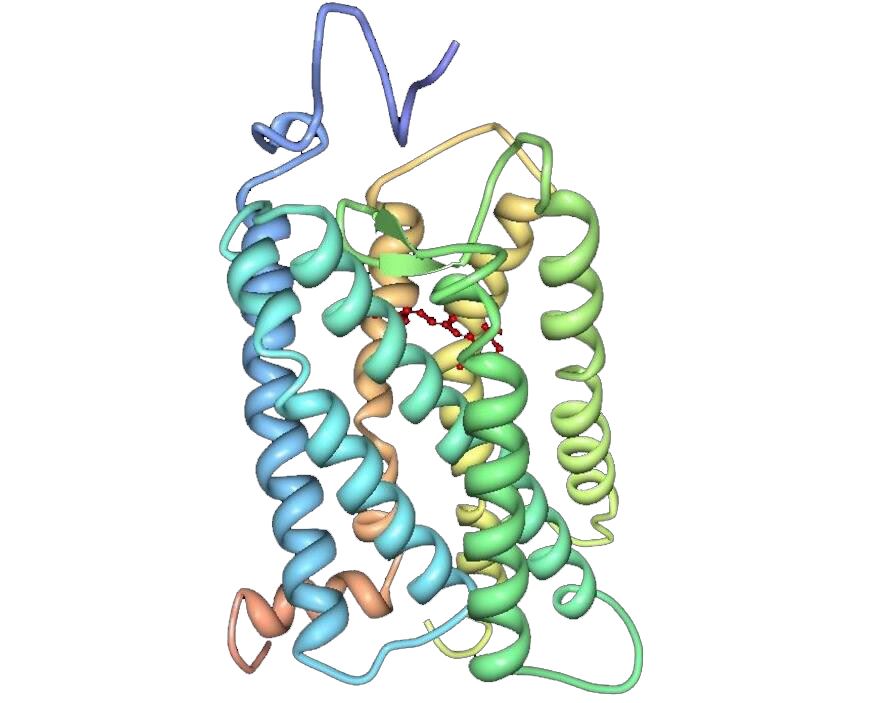Introduction of OPN1MW3
OPN1MW3 is encoded by the OPN1MW3 gene. It belongs to the G-protein-coupled receptor (GPCR) family which has been extensively studied during the past few decades. In vertebrates, cone opsins are classified into four phylogenetic groups: Ultraviolet-blue or short-wave-sensitive-1-cone-opsin group (SWS1), blue or short-wave-sensitive-2-cone-opsin group (SWS2), green or rod-opsin-like cone opsin group (RH2) and red-green or long-to-middle-wave-sensitive cone-opsin group (LWS/MWS). These proteins are light-absorbing molecules that mediate vision, and they consist of an apoprotein, opsin, covalently linked to cis-retinal.
| Basic Information of OPN1MW3 | |
| Protein Name | Medium-wave-sensitive opsin 3 |
| Gene Name | OPN1MW3 |
| Aliases | Medium-wave-sensitive opsin 3, Green cone photoreceptor pigment, Green-sensitive opsin, GOP, opsin 1 cone pigments medium-wave-sensitive 3 |
| Organism | Homo sapiens (Human) |
| UniProt ID | P0DN78 |
| Transmembrane Times | 7 |
| Length (aa) | 364 |
| Sequence | MAQQWSLQRLAGRHPQDSYEDSTQSSIFTYTNSNSTRGPFEGPNYHIAPRWVYHLTSVWMIFVVIASVFTNGLVLAATMKFKKLRHPLNWILVNLAVADLAETVIASTISVVNQVYGYFVLGHPMCVLEGYTVSLCGITGLWSLAIISWERWMVVCKPFGNVRFDAKLAIVGIAFSWIWAAVWTAPPIFGWSRYWPHGLKTSCGPDVFSGSSYPGVQSYMIVLMVTCCITPLSIIVLCYLQVWLAIRAVAKQQKESESTQKAEKEVTRMVVVMVLAFCFCWGPYAFFACFAAANPGYPFHPLMAALPAFFAKSATIYNPVIYVFMNRQFRNCILQLFGKKVDDGSELSSASKTEVSSVSSVSPA |
Function of OPN1MW3 Membrane Protein
Vertebrates typically have four cone opsins (LWS, SWS1, SWS2, and Rh2) inherited from the first vertebrate (and thus predating the first vertebrate), as well as the rod opsin, rhodopsin (Rh1), which emerged after the first vertebrate but before the first Gnathostome (jawed vertebrate). These five opsins emerged through a series of gene duplications beginning with LWS and ending with Rh1. Each one has since evolved into numerous variants and thus constitutes an opsin family or subtype. Then, OPN1MW is one of four forms. The OPN1MW of aberrant oncogene expression may underlie some forms of hereditary retinal degenerations. The OPN1MW also play a vital role in the cone photoreceptor degeneration that occurs in cone dystrophies and age-related macular degeneration. Since the red-green color vision of mammals is exclusively controlled by their LWS/MWS pigments, the OPN1MW may be a potential therapeutic target of red-green color blind.
 Fig.1 Structure of OPN1MW3 membrane protein.
Fig.1 Structure of OPN1MW3 membrane protein.
Application of OPN1MW3 Membrane Protein in Literature
This article evaluates exogenous 9-cis retinol produced robust sensitivity recovery in bleached red and blue cones but not in red and green rods, suggesting that cis retinol oxidation restricts access to the retina visual cycle to cones
The article shows that a rod pigment aromatic cluster does not improve the structural stability of the human green cone pigment. These mutants were designed in an attempt to increase the thermal stability by replacing weakly interacting side chains in the green pigment with their counterparts in rhodopsin with strong aromatic stacking interaction. All mutants produced wild-type levels of functional pigment, but none showed an increase in thermal stability.
The article reports that gene conversion in the OPN1LW/OPN1MW genes has been postulated, however, they are first to demonstrate a de novo gene conversion within the lineage of a pedigree.
The article shows that the abilities of rhodopsin to generate a large single photon response and to retain high thermal stability in darkness are factors that have been necessary for the evolution of scotopic vision.
This article reveals that spatially differentiated expression of quadruplicated green-sensitive RH2 opsin genes in zebrafish is determined by proximal regulatory regions and gene order to the locus control region. This combination of specificity and generality enables seemingly complicated spatial differentiation of duplicated opsin genes characteristic in fish.
OPN1MW3 Preparation Options
To obtain the soluble and functional target protein, the versatile Magic™ membrane protein production platform in Creative Biolabs enables many flexible options, from which you can always find a better match for your particular project. Aided by our versatile Magic™ anti-membrane protein antibody discovery platform, we also provide customized anti-OPN1MW3 antibody development services.
As a forward-looking research institute as well as a leading customer service provider in the field of membrane protein, Creative Biolabs has won good reputation among our worldwide customers for successfully accomplishing numerous challenging projects including generation of many functional membrane proteins. Please feel free to contact us for more information.
All listed services and products are For Research Use Only. Do Not use in any diagnostic or therapeutic applications.